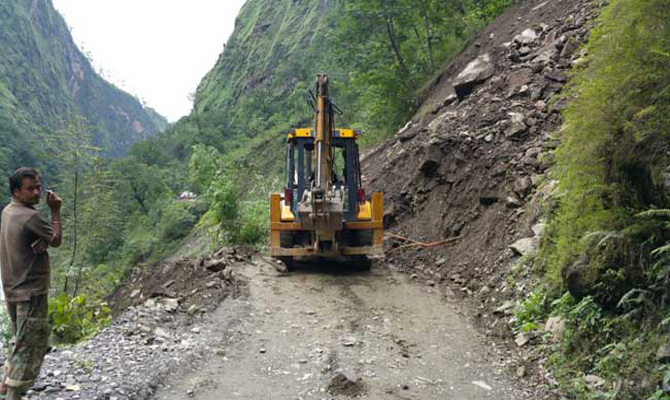With Prime Minister Narendra Modi, laying the foundation stone in December 2016, the construction of 900 km long highway has started and it has almost been 2 years since. According to the government, about 2000 crores work has been done, and other 10000 crores will be funded and worked shall been done by end of 2019.
The budget of 12000 crores was allotted for the project and the government promised the construction without harming the environment but today as per reports of various media we can see some very large amount of damage.
COURTESY : THE QUINT'S REPORT TO CHARDHAM MAHAMARG YOJANA.
The current Scenario,
25000 trees, that’s huge, enough to create a natural disaster and shake the entire Eco balances. Uttarakhand often known as “Land of the Gods”. And we humans here are demolishing the creation of God…..
Maintaining enough green cover for all the animal, bird species is need. We just can't let go or ignore the this kind of damage in terms of development. As we know India already has been among 5 worst countries in terms of environmental health. We are ranked 178th in terms of air quality. So, we have to take harsh steps to maintain green cover and re-establish the forests....
Out of 180 countries, India ranked 177, only better in environmental performance than the Democratic Republic of Congo, Bangladesh and Burundi. This is where they have to ponder and they have to act.
 |
| Courtesy : One India |
The budget of 12000 crores was allotted for the project and the government promised the construction without harming the environment but today as per reports of various media we can see some very large amount of damage.
COURTESY : THE QUINT'S REPORT TO CHARDHAM MAHAMARG YOJANA.
According to The Quint, around 25000 trees were cut, uprooted for laying the road along with streams being diverted from their natural way and relocation of large stones and river beds….As we know that, Uttarakhand is mountainous and full of lush green forests. To develop such routes, government must find a way doesn’t hinder the Eco system.
 |
| Courtesy : Sacred Yatra |
The current Scenario,
The trees are being uprooted and riverbed stones are relocated to highway diversions and turns. The trees must not uprooted or if they are uprooted they must be replanted to ensure that they live and Ecosystem is maintained. The rocky waste being dumped at turns may create blockage for waterfalls, as turns are mostly near streams or waterfalls, heavy rainfall in those dump areas may wash out this dumping sites.
For making the highways, mountain slopes are steep cut, as if 90 degrees straight. This is the wrong method as they have higher risk of landslides. With one rain, it can ruin entire work by the government. With deadline coming close, the work as begun heftily, and working fast can also result into dangerous yet losses. Simply saying it will block the ongoing roots for days....
25000 trees, that’s huge, enough to create a natural disaster and shake the entire Eco balances. Uttarakhand often known as “Land of the Gods”. And we humans here are demolishing the creation of God…..
So what should be done???? - By The Quint
How to minimise deforestation during road cutting?
Construction of roads in the eco-sensitive Garhwal region is challenging, as they cannot be constructed in a straight, linear manner. Hence, diversions and tunnels should be constructed wherever possible so that lesser trees are cut. But the government is in a hurry to complete the 2019 deadline. With more time and planning, lesser trees could have been cut.
What is the proper way to redevelop Kedarnath?
In the report, we had suggested that no development work should take place beyond Sonprayag. Instead, smart buffer zones should be created in towns below Sonprayag, where pilgrims can be managed according the carrying capacity of the place. The flow of pilgrims can be regulated in a step-by-step manner, and at a time, up to 500 people can be allowed in the hill-top shrine of Kedarnath. The buffer zones can be called smart only if they environment friendly and provide rapid access to rapid evacuation routes, in the event of an emergency.
Dr Srivastav maintains that every place has its own carrying capacity. In the steep-gradient of Kedarnath, the weather can change at any time. The government, he maintains, must be mindful of the limits of nature. Else, injudicious development, can lead to the possibility of yet another disaster.
Maintaining enough green cover for all the animal, bird species is need. We just can't let go or ignore the this kind of damage in terms of development. As we know India already has been among 5 worst countries in terms of environmental health. We are ranked 178th in terms of air quality. So, we have to take harsh steps to maintain green cover and re-establish the forests....
 |
| Courtesy: Hindustan Times. |
Out of 180 countries, India ranked 177, only better in environmental performance than the Democratic Republic of Congo, Bangladesh and Burundi. This is where they have to ponder and they have to act.
No comments:
Post a Comment